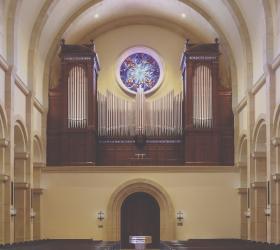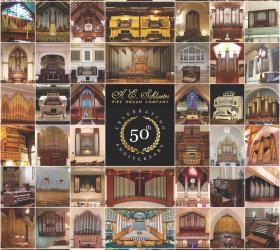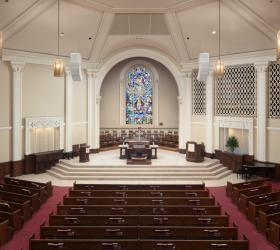
Spivey Hall, Clayton State
University, Morrow, Georgia
The Albert Schweitzer
Memorial Organ
Fratelli Ruffatti, Padua, Italy
Organ Curator: Widener and Company, Inc., Grayson, Georgia
Spivey Hall’s Albert Schweitzer Memorial Organ Reflects Founders’ Vision of Artistic Excellence
Spivey Hall in Morrow, Georgia, is lauded internationally for its stunning architecture and extraordinary acoustics. Spivey Hall marked its 25th season last year, and this year will celebrate another significant milestone in its history—the silver anniversary of the majestic Albert Schweitzer Memorial Organ, the 4,413-pipe organ that for the past 25 years has filled the auditorium with awe-inspiring sound.
Spivey Hall and the organ were the vision of Emilie Spivey and her dentist husband Walter, successful south Atlanta real estate developers who wanted to construct a small, elegant concert hall as a gift to Clayton State University and the surrounding community. The couple established the Walter and Emilie Spivey Foundation and led the $4.5 million fundraising with an initial $1 million challenge gift. In 1991, Spivey Hall opened to the public, and a year later, the Foundation donated an additional $800,000 for the design, construction, and installation of the organ. Neither Walter nor Emilie lived to see the completion of the hall, but Emilie’s dream lived on in its reputation for attracting the finest international artists, many of whom praised Spivey Hall as a favorite performance venue and would return again and again. The 400-seat hall’s success relied on a simple thesis—people love to hear timeless music played by great musicians in a beautiful setting.
The organ was not in place when Spivey Hall presented its first concerts, but was well under construction several thousand miles away in Padua, Italy. Emilie, an accomplished church organist, was enamored by the instruments created by Italian organ builders Fratelli Ruffatti, and early in the hall’s design phase had commissioned the firm to design an organ that would be the crowning masterpiece.
The Albert Schweitzer Memorial Organ pays tribute to the organist, Bach scholar, theologian, philosopher, physician, and humanist Dr. Albert Schweitzer (1875–1965), who in 1953 became the first professional musician to be awarded the Nobel Peace Prize. Schweitzer was interested in the historic organs of France and Germany and in organbuilding itself. His extensive writings praised the correctness of earlier approaches and eschewed many of the late 19th- and 20th-century changes to the “King of Instruments”; his ideas contributed decisively to the revival of classical techniques in building and voicing organs. Schweitzer had a direct influence on the emergence of comprehensive (rather than heavily Romantic) instruments built in recent decades, by such organbuilders as the Ruffattis.
To carry out Emilie’s vison of the tonal scheme, specifications were selected by a team of consultants, including Ted Alan Worth of the Ruffatti organization, as well as trusted colleagues Joyce Jones, John Weaver, and Richard Morris. The selection of registers was made with the primary objective of creating a versatile instrument, capable of performing music from all periods and styles of organ composition—the modest, straightforward tunes of the great Baroque masters, flamboyant colors favored by 19th-century French organists, and the subtle shadings of the modern repertoire.
Francesco Ruffatti took personal responsibility for realizing the tonal design—the choice of shapes, dimensions, and a myriad of other variables in the construction of the pipes. Electronic stops were commissioned from Walker Technical Company of Zionsville, Pennsylvania. Piero Ruffatti, who worked closely with Spivey Hall architect B. Randall Smith of Gardner Spencer Smith and Associates in Atlanta and acoustician Rein Pirn of Acentech in Boston, designed the faux marble and gold leaf casework to ensure it would complement the architecture, acoustics, and décor of the hall. Indeed, the height of the organ pipes and their place in the design of the auditorium play a major role in its world-class acoustical properties that inspire artists and audiences alike.
The instrument was disassembled and shipped piece by piece from Padua to Atlanta in January 1992, in two shipments totaling 80,000 pounds. The case was shipped unfinished and decorated by Spivey Hall interior designer Gerald Underwood. The casework, 50 feet high and 37 feet wide, encloses a total volume of 14,800 cubic feet. The entire process of creating the organ, from the crafting of pipes in the Ruffatti factory in Italy and the shipments across the ocean to Atlanta to the complex stages of installation at the Hall, was documented in a 1992 Georgia Public Television production, Architects of Sound.
Spivey Hall closed for six months between 1991 and 1992 while the instrument was installed under the supervision of Piero Ruffatti. Among the installation team was Thomas J. McCook, Jr. of Widener and Company, who remains curator of the organ to this day. Tonal finishing—adjusting the quality and intonation of each pipe individually—was begun during the installation process and continued right up until its official dedication in May of 1992 with three concerts: two by the acclaimed British organist Gillian Weir, and the finale, which joined the talents of Robert Shaw and his Festival Singers with organist Norman Mackenzie. The hall’s stature in the organ world fully came to prominence in 1998, when the Royal Bank Calgary International Organ Festival & Competition chose Spivey Hall as the site for its North American selection rounds; the quadrennial event returned there in May of 2002.
In Spivey Hall’s 26th season (2016–17), the Albert Schweitzer Memorial Organ takes pride of place on its 25th anniversary, which coincides with the launch of the five-season McGehee Family Organist Residency held by Alan Morrison, who in 2015 added Spivey Hall Organist-in-Residence to his distinguished appointments as Haas Charitable Trust Chair in Organ Studies at the Curtis Institute of Music, faculty member of Westminster Choir College of Rider University, and college organist at Ursinus College. The anniversary celebrations begin with an “Organ Discovery Day” on September 10, which includes a performance by Morrison, audience Q&A, and the chance to come on stage to see the organ console up close. Morrison is also featured with Thomas McCook of Widener and Company and Dwight Jones, founding president of Integrated Organ Technologies, Inc. (IOTI), in the public premiere of Spivey Hall Education’s award-winning new video, The King of Instruments: History, Science and Music of the Pipe Organ, written and directed by Marshall Peterson.
Spivey Hall’s Organ Series includes recitals from Morrison, Stephen Tharp, and Hector Olivera. Steven Ball, organist of Atlantic City’s Boardwalk Hall (one of the world’s largest pipe organs), will pair with mime Dan Kamin in a special silent-film-and-organ presentation of Funny Bones: The Comedy of Charlie Chaplin.
The series concludes on May 13 with the Albert Schweitzer Memorial Organ 25th Anniversary Celebration, showcasing the mastery of three extraordinary organists: Morrison, Ken Cowan, and Cherry Rhodes. American Public Media host Michael Barone will join Morrison in a pre-concert talk; Spivey Hall organ performances featured on Barone’s radio program Pipedreams have brought the music of the Schweitzer Memorial Organ to millions of listeners nationwide and around the world.
Details and tickets to all Spivey Hall Season 26 concerts and events, including the Albert Schweitzer Memorial Organ 25th Anniversary Celebration, can be found at spiveyhall.org.
— Samuel C. Dixon
From the Organbuilder
The Ruffatti organ at Spivey Hall holds a special place in our hearts. Although we have crafted a number of much larger instruments in North America, this three-manual beauty represents the perfect combination of well-balanced tonal resources, blending of sound with room acoustics, and integration of case design with surrounding architecture. It is impossible to enter Spivey Hall and not be impressed by the magnitude of the instrument’s physical presence and beauty; likewise, it is impossible to imagine the hall without it. The auditorium acoustics blend and amplify the tonal properties of the instrument to provide a natural presence of sound and reverberation. This rare combination has greatly contributed to the fame of the instrument and its success over the years.
Twenty-five years represent a small period of time in the life of a pipe organ: a high number of instruments survive that count several centuries of life and use. If well built, with high-quality materials and a good technical and tonal masterplan in mind, the instrument will continue to deliver satisfying and inspiring tonal resources to the artist with long-lasting top technical performance, and such is the case with the Spivey Hall organ. Fratelli Ruffatti (Ruffatti Brothers) is and has always been structured as a family business, where every detail is made from scratch with traditional methods, and where strict quality control is the routine. Inside this organ, one finds pipes, windchests, and even walkboards made of solid Sipo mahogany for stability. Metal pipes are made from a variety of alloys that we mix and pour in our factory, tailored to produce the best sound from each stop. For tonal finishing, we have revisited and adapted ancient Italian voicing techniques to contemporary organbuilding. This practice preserves the widest range of harmonics that favor perfect blending of sounds. The resulting versatility allows the performer to create countless combinations of voices for the performance of organ literature from any era.
We are delighted to join with Spivey Hall in celebrating the Albert Schweitzer Memorial Organ. As it began its life in the 20th century, we look forward to continuing to hear and celebrate it throughout the 21st century and beyond.
—Fratelli Ruffatti
Padua, Italy
GREAT (II, unenclosed)
16′ Montre 61 pipes
16′ Bourdon 61 pipes
8′ Montre 61 pipes
8′ Bourdon 61 pipes
8′ Flûte Harmonique 61 pipes
4′ Prestant 61 pipes
4′ Flûte Octaviante 61 pipes
22⁄3′ Quinte 61 pipes
2′ Doublette 61 pipes
13⁄5′ Tierce 61 pipes
11⁄3′ Fourniture IV 244 pipes
1⁄2′ Cymbale III 183 pipes
16′ Bombarde 61 pipes
8′ Trompette 61 pipes
8′ Trompette-en-Chamade 61 pipes
Chimes
Tremulant
Great 16′
Unison Off
Great 4′
SWELL (III, expressive)
16′ Gedeckt 61 pipes
8′ Principal 61 pipes
8′ Viole de Gambe 61 pipes
8′ Viole Céleste 61 pipes
8′ Flûte a Cheminée 61 pipes
8′ Flauto Dolce 61 pipes
8′ Flûte Céleste (TC) 49 pipes
4′ Principal 61 pipes
4′ Flûte Venetienne 61 pipes
22⁄3′ Nazard 61 pipes
2′ Flûte a Bec 61 pipes
13⁄5′ Tierce 61 pipes
2′ Plein Jeu III 183 pipes
1⁄2′ Cymbale II 122 pipes
16′ Petite Bombarde 61 pipes
8′ Trompette 61 pipes
8′ Hautbois 61 pipes
8′ Voix Humaine 61 pipes
8′ Echo Voix Humaine †
4′ Clairon 61 pipes
8′ Trompette-en-Chamade (Great)
Tremulant
Voix Humaine Tremulant
Swell 16′
Unison Off
Swell 4′
CHOIR/POSITIF (I, expressive)
16′ Dulciana 61 pipes
8′ Viola Pomposa 61 pipes
8′ Viola Celeste 61 pipes
8′ Holzgedackt 61 pipes
8′ Erzähler 61 pipes
8′ Erzähler Celeste 61 pipes
4′ Ottava 61 pipes
4′ Koppelflöte 61 pipes
22⁄3′ Nazard 61 pipes
2′ Fifteenth 61 pipes
2′ Flute 61 pipes
13⁄5′ Tierce 61 pipes
11⁄3′ Larigot 61 pipes
1′ Sifflöte 61 pipes
1′ Ripieno IV 244 pipes
16′ Basson 61 pipes
8′ Trompette Harmonique 61 pipes
8′ Cromorne 61 pipes
8′ English Horn 61 pipes
4′ Chalumeau 61 pipes
8′ Trompette-en-Chamade (Great)
8′ Harp
4′ Celesta
Chimes (Great)
Zymbelstern 11 bells
Tremulant
Choir/Positif 16′
Unison Off
Choir/Positif 4′
PEDAL (unenclosed)
32′ Contra Principal *
32′ Contre Bourdon *
16′ Principal 32 pipes
16′ Montre (Great)
16′ Soubasse 32 pipes
16′ Bourdon (Great)
16′ Gedeckt (Swell)
16′ Dulciana (Choir/Positif)
8′ Octave 32 pipes
8′ Flute 32 pipes
8′ Gedeckt (Swell)
4′ Prestant 32 pipes
4′ Nachthorn 32 pipes
2′ Piccolo (extension) 12 pipes
22⁄3′ Mixture IV 128 pipes
32′ Contre Bombarde 32 pipes
16′ Bombarde 32 pipes
16′ Bombarde (Great)
16′ Petite Bombarde (Swell)
16′ Basson (Choir/Positif)
8′ Trompette 32 pipes
4′ Clairon 32 pipes
4′ Chalumeau (Choir/Positif)
8′ Trompette-en-Chamade (Great)
4′ Clairon-en-Chamade (Great)
Chimes (Great)
Inter-Manual Couplers
Swell to Great 16, 8, 4
Choir/Positif to Great 16, 8, 4
Swell to Choir/Positif 16, 8, 4
Choir/Positif to Swell 8
Great to Choir/Positif 8
Great to Pedal 8, 4
Swell to Pedal 8, 4
Choir/Positif to Pedal 8, 4
Combination Pistons
Generals 10
Great 8 + Cancel
Swell 8 + Cancel
Choir/Positif 8 + Cancel
Pedal 8 + Cancel
General Cancel
Tutti (Full Organ)
64-level Memory (Solid-State Logic Limited)
Adjustable Crescendo Pedal Settings 4
Statistics
Pipes 4,413
Ranks 79
Electronic Ranks 2
Speaking Stops 88
† The Voix Humaine has 61 pipes, enclosed in a dedicated box, with a hinged lid. When the Voix Humaine stop knob is drawn, the lid is open, when the Echo Voix Humaine stop is drawn the lid is closed.
* Electronic: custom built by Walker Technical Services of Zionsville, Pennsylvania




